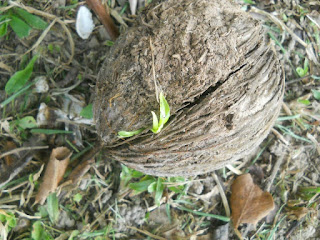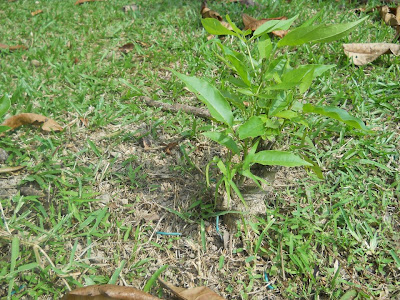Apple snail (Ampullariidae)
Kingdom: Animalia
Phylum: Mollusca
Class: Gastropoda
Apple snails is a family of large freshwater snails , it has both a lung and a gill.
Dragonfly (Anisoptera)
Kingdom: Animalia
Phylum: Arthropoda
Class: Insecta
Order: Odonata
A dragonfly is a double-winged insect, it has large multifaceted eyes, two pairs of strong transparent wings, and an elongated body.
 |
| the cockroach can be found near the leaf stalk |
Cockroach (Blattaria)
Kingdom: Animalia
Phylum: Arthropoda
Subphylum: Hexapoda
Class: Insecta
Order: Blattodea
Cockroach has spines on its legs to help in locomotion on difficult terrain, the egg capsule of a cockroach contains around 40 eggs.
Fruitfly (Drosophila melanogaster)
Kingdom: Animalia
Phylum: Arthropoda
Class: Insecta
Order: Diptera
Family: Drosophilidae
Genus: Drosophila
Fruit flies have brick red eyes, are yellow-brown in color, and have transverse black rings across their abdomen.
Kingdom: Animalia
Phylum: Arthropoda
Class: Insecta
Order: Hymenoptera
Family: Formicidae
Genus: Lasius
Species: Lasius niger
Lasius niger colonies can reach in size up to around 15,000 workers but 4,000–7,000 is around average. A Lasius niger queen can live for around 12 years.
Kingdom: Animalia
Phylum: Arthropoda
Class: Insecta
Order: Orthoptera
Grasshoppers have antennae that are generally shorter than their body and short ovipositors. They also have pinchers or mandibles that cut and tear off food.Grasshoppers prefer to eat grasses, leaves and cereal crops
------------------------------------------------------------------------------------------------------------
Bird Nest Fern (Asplenium nidus)
Kingdom: Plantae
Phylum: Pteridophyta
Class: Polypodiopsida
Order: Polypodiales
Family: Aspleniaceae
Genus: Asplenium
Species: Nidus
The fronds of the bird nest fern grows up to 50-150 cm long and 10-20 cm broad. They are light green, often crinkled, with a black midrib, and exhibit circinate vernation. The spores develop in sori on the underside of the fronds.
Heliconia (Heliconia Inflorescences)
Kingdom: Plantae
Order: Zingiberales
Family: Heliconiaceae
Genus: Heliconia
Heliconia range from 0.5 to nearly 4.5 meters (1.5–15 feet) tall depending on the species. The simple leaves of these plants are 15–300 cm (6 in-10 ft). They are characteristically long, oblong, alternate, or growing opposite one another on non-woody petioles often longer than the leaf, often forming large clumps with age. Their flowers are produced on long, erect or drooping panicles, and consist of brightly colored waxy bracts, with small true flowers peeping out from the bracts.
Pong pong (Cerbera odollam)
Kingdom: Plantae
Order: Gentianales
Family: Apocynaceae
Genus: Cerbera
Species: Cerbera odollam
The cerbera odollam is commonly known as the suicide tree as it yields a potent poison, often used for suicide or murder. The fruit, when still green, looks like a small mango, with a green fibrous shell enclosing an ovoid kernel measuring approximately 2 cm × 1.5 cm and consisting of two cross-matching white fleshy halves.
Ixora
Kingdom: Plantae
Phylum: Angiosperma
Class: Asterids
Order: Gentianales
Family: Rubiaceae
Genus: Ixora
Species: Coccinea
Ixora prefer acidic soil, in tropical climates they flower year round. It has leathery leaves, ranging from 3 to 6 inches in length, and produce large clusters of tiny flowers in the summer.













.jpeg)
.jpeg)
.jpeg)
.jpeg)


